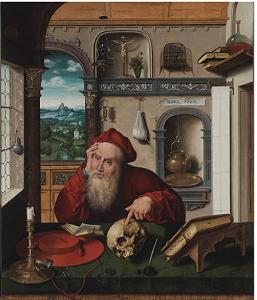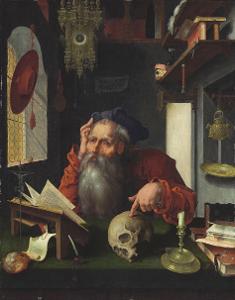Joos van Cleve and workshop
Saint Jerome in his study
Oil on panel : 99,7 X 83,8 cm
Unsigned, after 1521
Cambridge (Ma), Harvard University Museums
This is a comparative item

Painting for Sale
In short
Around 400 AD Saint Jerome wrote the Latin version, the so-called Vulgate, of the Bible. Erasmus corrected his translation of the New Testament at the start of the 16th century.
The portrayal of Saint Jerome as a Humanist scholar in his study, thinking of the faith of mankind, goes back to an iconic painting from 1521 by the German Renaissance painter Albrecht Dürer. The skull, the candle and the clock were popular Vanitas elements.
About Saint Jerome
Stridon (near present-day Ljubljana) circa 347 – 420 near Bethlehem
Catholic saint, doctor of the church and one of the four Latin church fathers, with Saint Augustine, Saint Ambrose and Pope Gregory I.
Author of the definitive and officially promulgated Latin version of the Bible of the Roman Catholic Church, the so-called Vulgate, which he translated from the Hebrew and from the Greek. Saint Jerome is one of the most voluminous writers of ancient Latin Christianity, second only to Saint Augustine.
About the iconographic sources used during the 16th century to represent Saint Jerome
Representations of Saint Jerome were extremely popular in Flemish painting during the 16th century: it is thought that some 30% of all paintings of saints of that period depict Saint Jerome.
The two main, but opposite, iconographic sources for these 16th century painters were the Golden Legend and Erasmus.
1. The ‘Legenda aurea’ or Golden Legend was a medieval collection of legendary lives and accounts of miracles of important Christian saints compiled around 1260 by Jacobus de Voragine, the archbishop of Genoa. Painters inspired by the Golden Legend would represent Saint Jerome as a lonely anchorite in the wilderness during his most intense period of asceticism when, between 375 and 378, he had retired in the Syrian dessert. He is a Roman saint, a praying hermit renouncing temptation in front of a crucifix, often doing penance with a stone. The skull in front of him is a Vanitas symbol, referring to the vanity of earthly life.
2. The second source of inspiration to represent St Jerome was the Humanist Erasmus (Rotterdam 1466 – 1536 Basel). He had sought to demystify saints, especially Saint Jerome: he wrote a new biography of our saint (based on Jerome’s own letters and publications) and he also wrote two new critical publications of the New Testament: the ‘original’ Greek version and his translation into Latin, for he thought Saint Jerome had not completely correctly translated it. Because St Jerome had translated the bible and thus because of his knowledge of several languages, his erudition and his intelligence St Jerome became the model for 16th century Renaissance Humanists. Towards the middle of the 16th century artists inspired by Erasmus no longer represent St Jerome as a Roman saint, but as a real man, as a Renaissance Humanist scholar in his study, amidst a multitude of objects.
One element from the Golden Legend that Erasmus had proved to be erroneous did survive in Humanist representations: the cardinal’s red tunica and red galero (a cardinal’s hat used for travelling). Cardinals were indeed not known until three centuries later than Jerome’s time. Because the other three Church Fathers held high positions in the Church (Augustine and Ambrose were bishops, Gregory a pope) and were represented in ecclesiastical costumes, and as Saint Jerome held a dignified office in Rome between 383 and 385 as secretary and counselor of Pope Damasus I, it had seem fitting to continue to picture him as a cardinal.
About our painting
In a Renaissance study breathing the atmosphere of Humanism, of Erasmus, Saint Jerome is reflecting upon the faith of man, upon the transitoriness of all. Objects referring to the theme of Vanitas add to the meditation of death and the ephemeral character of life: the clock, the blown out candle, the skull. The skull represents the seat of thought, and also symbolized spiritual perfection. Death of the physical body (symbolized by the skull) enabled one to be reborn at a higher level at which the spirit could rule. The open bible indicates that Jerome, known for his knowledge and wisdom, could understand the mysteries of the universe. The Latin text behind the saint reads as follows: “memorare novissima tua et in Aeternum no(n) peccabis” meaning “remember your last days and you will not sin forever”. It is taken from Ecclesiasticus 7:40 from Sant Jerome’s Vulgate.
Saint Jerome’s contemplative pose goes evidently back to the painting from the Museu Nacional de Arte Antiga in Lisbon, painted in 1521 by the famous German Renaissance painter and engraver Albrecht Dürer (1471 – 1528): his right hand rests against is head, the index of the left hand touches the skull. This painting formed the starting point from which an important number of 16th century German, Flemish and Dutch painters made an important number of variations. In March 1521, during his successful journey of eleven months in the Low Countries, Dürer painted in Antwerp a small panel zoomed in on an old, tired, but still vigorous and melancholic Saint Jerome. He presented this painting to a Portuguese business agent that he had befriended, Rodrigo Fernandez d’Almada. On the preparatory drawing that served as the basis for the painting Dürer wrote that he had portrayed a 93 years old inhabitant from Antwerp, who was still healthy and strong. Amongst the most important early Flemish painters who regularly represented Saint Jerome in his study I should mention Joos van Cleve (circa 1485 – 1541) and Pieter Coecke van Aelst (1502 – 1550).
The saint is the archetypal scholar. In 1972 in his “Early Netherlandish Painting” Max Friendländer explained this as follows: “On the eve of the struggles of the Reformation, the learned, brooding searcher after God represented an appropriate ideal”. The popularity in Antwerp and in Flanders during the second and the third quarter of the 16th century of the representation of Saint Jerome must of course be explained as the result of a growing criticism on the Catholic Church and its leaders and an increasing popularity of the Reformation. This way people saw Saint Jerome not only wondering about the inevitability of death and the nearness of the Last Judgment, but also as a troubled figure agitated by the existence of religious leaders who do not practice what they preach.
Why should you buy this painting?
Because this is a true philosophical icon of Renaissance and Humanism in Flemish 16th century painting.
Comparative paintings
Click photos for more details












